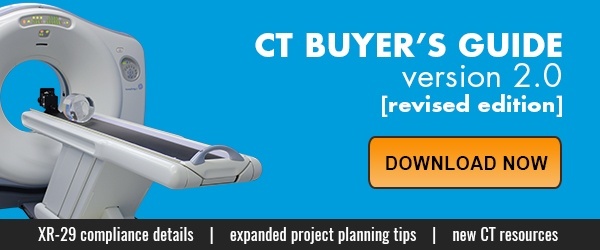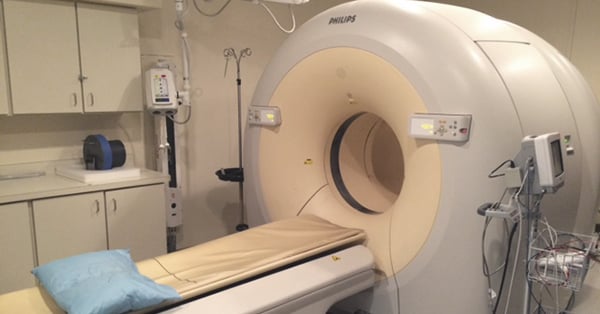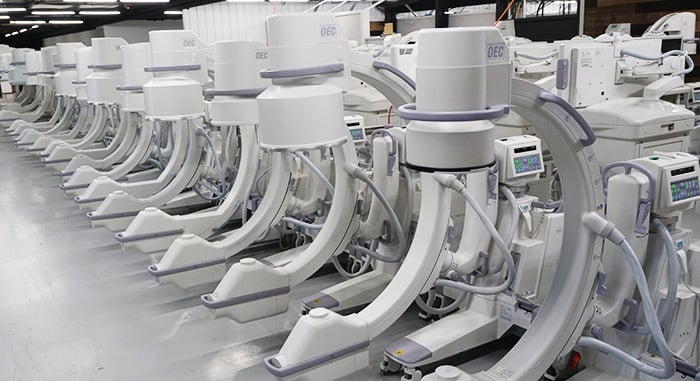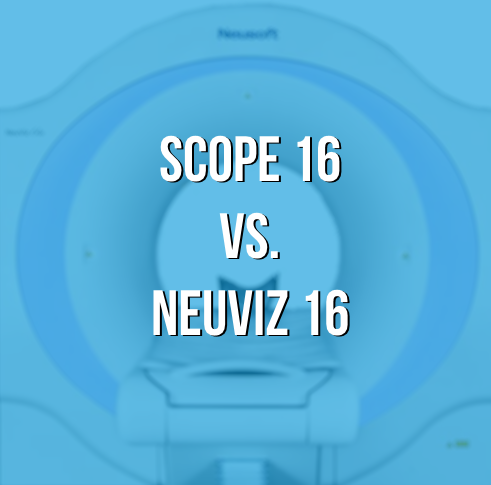
If you're looking into a Siemens Scope 16, chances are you're after a compact, budget-conscious, 16-slice CT system. The Scope lives up to those requirements, but that isn't the end of the story.
While the Scope will satisfy in some regards, there are some design decisions made by Siemens that limit the utility of this platform. Depending on your facility's needs, these may or may not be "dealbreakers", but it is important that you be aware of them.
It's also important that, if they are dealbreakers, you be aware of an alternative to consider. To that end, we've put together the following to compare the Scope 16 with Neusoft's NeuViz 16 across several criteria.
Footprint
At 8m/sq, the Scope has the smallest footprint of any 16-slice CT. Being this compact makes it a good candidate for a physician's office or in a mobile setting to be shared among sites. By comparison, the NeuViz 16 has a footprint of 18m/sq. While this is a significantly larger footprint, it should be noted that the majority of existing CT rooms were built to accomodate older, larger CTs with footprints around 25m/sq.
Ultimately, either of these systems constitutes a space savings over most systems that are at replacement age. If you're installing into an existing room, the extra gains of the Scope are a moot point. If you're starting fresh in a place where space will be an issue, the Scope can fit where other scanners can't.
Maximum kV
When using a Scope 16 the maximum available kilovolt (kV) station is 130. Below is a graph that shows the CT "contrast to noise ratio" at various kiloelectronvolt (keV) settings. As kV increases, so does keV, which reduces contrast and, thereby, image quality until the relationship between kV/keV and contrast goes from inverse to converse around 140 kV. This station is beyond the reach of the Scope 16, but within the range of the NeuViz 16.
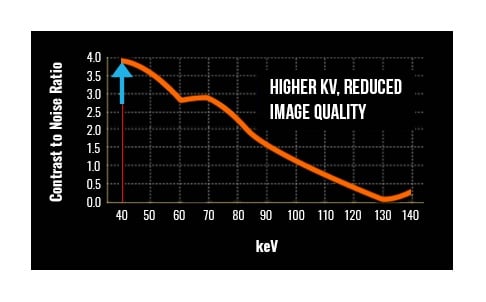
The first response to this issue that I normally hear is, "Well, you could use 110 kV." That solution might work for small to average-sized patients but, unfortunately, 110 kV is not adequate for patients with a BMI over 20. A 130 maximum kV station does not provide the reserve penetration that a 140 kV station will.
The maximum kV of the Scope makes it adequate for about 80% of the patients a given hospital might want to scan. The other 20%, including patients with a 20+ BMI or those who need scans like multi-phase GI exams will need the higher kV provided by the NeuViz 16.
Maximum mA
The Scope 16 has a maximum miliamp (mA) output of 345. This max mA is a limiting factor in several areas. The most obvious of these is penetration for larger patients. For comparison, the NeuViz 16 has a maximum mA of 420. Because mA and dose share a linear relationship, the Scope 16 has 21% less dose available for imaging larger patients than the NeuViz 16.
A lower maximum mA also means there will be fewer miliampere-seconds (mAs) available. Because of this, smaller pitches and lower rotation speeds are required to scan larger patients. This has the potential to increase patient dose even further beyond the increase necessitated by their size.
Detector Coverage
Detector coverage is the measure of how much anatomy the CT covers per rotation. The Scope 16 has a maximum detector coverage of 192mm while the NeuViz 16 covers 240mm. This means that the Scope has 25% less detector coverage and will need that much more time to cover the same anatomical region as the NeuViz.
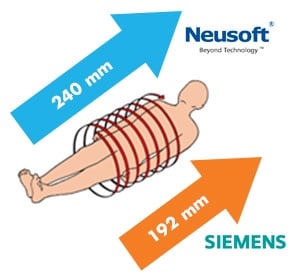
Scan time relates directly to patient dose. Consider this in conjunction with the limitations on pitch due to available mAs and the potential for higher patient dose becomes evident.
Iterative Reconstruction
Current iterative reconstruction (IR) products operate on both image data and raw data to remove noise and artifacts and make low-dose images more diagnostic. The IR product offered on the Scope is the first generation from Siemens, called image reconstruction image space (IRIS).
"Image space" is another name for image data. As spelled out in the product's designation, IRIS only operates on image data and not raw data. Unfortunately, electronic and photon noise can only be removed in raw data. Once the noise is reconstructed into the image it cannot be removed. This means that IRIS is only partially effective in cleaning up images.
A common response to some of the higher dose and lower power design elements of the Scope is that using IR will reduce the amount of power you need for imaging so that higher mA and kV won't be necessary. While this may be true for IR products that work on both image data and raw data, it is not true of a product like IRIS that only works on image data. Because IRIS only operates on a portion of the data that makes up a CT image, it cannot fully compensate for inadequate power or poor dose efficiency.
The NeuViz 16, on the other hand, does not feature an IR product. The higher kV and mA settings and the dose efficiency afforded by its higher detector coverage are countermeasures against image noise and artifact, providing "cleaner" data to begin with.
The Takeaway
Overall, The Siemens Scope 16 is a solid scanner that will serve users well for the majority of common scans on the majority of patients. It will take up less space, if that's a major concern, and, if having iterative reconstruction is a major concern, it will provide at least a portion of the capabilities of current IR products.
If your facility is looking for a scanner with a broader range of utility, the NeuViz 16 would be a better pick. The available kV and mA make it useful for the studies the Scope can handle, but also for studies that simply require more power. It also reduces dose by covering more anatomy per rotation via greater detector coverage.
If you're ready to start a conversation about your next CT scanner purchase, we're here to help. Contact us here.
If you'd like to continue learning about Neusoft CT products, we can help with that too:
Neuviz 16 Ct Scanner vs. Lightspeed 16 Ct Scanner
Neuviz 64 Series CT Scanners Compared
.........................
Courtesy of guest contributor: Keith Mildenberger
Keith has been in the diagnostic imaging business since 1983. Having held service, management, marketing, and sales positions, he has developed a broad base of experience in areas impacting the diagnostic imaging community and the patients it serves. He has been part of MITA since 2011 and involved with all aspects of NEMA XR-29, including its authorship. He is currently the CT Product Manager for Neusoft Medical Systems USA, Inc.

Paul Crawford
Paul Crawford is the Vice President of Equipment Solutions at Block Imaging. Paul connects with healthcare facilities across the world to offer CT solutions and manages the wholesale sales team. When Paul is not helping customers with their CT needs, he enjoys spending time with his family, watching MSU sports, and CrossFit.



